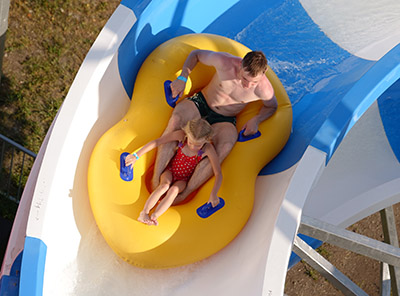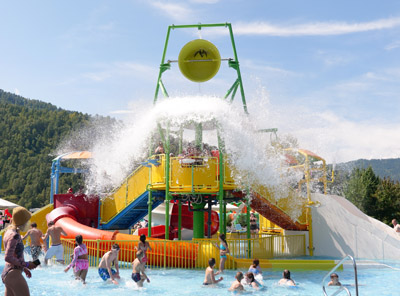Integrating Natural Landscapes into Water Park Design: Strategies for Harmonious and Immersive Experiences
Water parks that blend seamlessly with their natural surroundings offer visitors a unique escape, combining the thrill of aquatic attractions with the tranquility of outdoor environments. This approach not only enhances aesthetic appeal but also promotes sustainability and ecological awareness. By leveraging local topography, vegetation, and water sources, designers can create spaces that feel like an extension of the natural world rather than an imposition upon it.
Leveraging Existing Topography and Geological Features
One of the most effective ways to integrate natural landscapes is by working with the land’s inherent contours. Hills, valleys, and rock formations can shape the layout of slides, lazy rivers, and pool areas, reducing the need for extensive excavation or artificial structures. For example, a slide can be designed to follow the slope of a hill, using gravity to propel riders while minimizing energy consumption. Rocky outcrops can serve as natural barriers or focal points for themed attractions, such as grottoes or waterfalls.
Water bodies like lakes, rivers, or ponds can be incorporated into the park’s design to create a cohesive aquatic ecosystem. A lazy river might wind through a marshy area, allowing visitors to float past native plants and wildlife. Existing streams can be enhanced with gentle cascades or rock pools, providing both visual interest and natural filtration for the park’s water systems. By preserving these features, designers reduce environmental disruption and create a sense of place that resonates with local geography.
Selecting Native Vegetation for Shade and Aesthetics
Plant life plays a dual role in water park design: it offers shade and cooling while enhancing the natural ambiance. Native trees, shrubs, and flowers are ideal choices because they require less maintenance, resist local pests and diseases, and support regional biodiversity. Strategic placement of vegetation can define pathways, create private seating areas, or frame views of key attractions. For instance, tall palm trees might line the entrance to a tropical-themed section, while willow trees could provide dappled shade over a picnic area near a lake.
Aquatic plants like water lilies, cattails, and reeds can be used to soften the edges of pools and water features, creating a more organic transition between built and natural elements. These plants also improve water quality by absorbing nutrients and providing habitat for fish and insects. In areas prone to erosion, deep-rooted grasses or groundcovers can stabilize soil along slide exits or riverbanks, preventing sediment from muddying the water. By prioritizing native species, designers ensure the park’s landscaping thrives with minimal intervention.
Designing Water Features That Mimic Natural Processes
Artificial water features can be crafted to resemble natural phenomena, enhancing the park’s authenticity. Rock slides with irregular surfaces and gradual curves mimic the appearance of mountain streams, while splash pads with scattered boulders and shallow pools evoke the feel of a creek bed. Waterfalls are particularly effective at creating drama; designers can vary their height, width, and flow rate to replicate everything from a gentle trickle to a thunderous cascade. Incorporating recirculation systems ensures these features remain sustainable, using pumps to return water to the top without excessive waste.
Lighting and sound design further amplify the natural aesthetic. Underwater LEDs can illuminate pools with soft blues and greens, mimicking the play of light on a lake’s surface. Ambient noise machines or strategically placed speakers might broadcast sounds of birdsong, rustling leaves, or flowing water to mask the hum of machinery and immerse visitors in a serene atmosphere. During evening hours, fire pits or torches near seating areas can add warmth and a rustic charm, encouraging guests to linger long after sunset.
Creating Themed Zones Inspired by Local Ecosystems
Themed areas allow water parks to tell a story about the surrounding environment, deepening visitors’ connection to the location. A park near a desert might feature a “Oasis” zone with sandy beaches, palm groves, and winding rivers that disappear into rocky canyons. Coastal parks could include a “Tidal Pool” area with saltwater pools, tide-inspired wave machines, and artificial reefs teeming with marine life. These themes not only celebrate regional identity but also educate guests about local ecosystems and conservation efforts.
Interactive elements can enhance thematic zones. For example, a rainforest-themed section might include a treetop walkway where visitors can observe simulated wildlife or learn about plant species through interpretive signage. A mountain zone could offer guided tours explaining how slides were designed to follow natural contours, highlighting the park’s commitment to sustainability. By engaging multiple senses, these experiences leave a lasting impression and foster appreciation for the natural world.
Sustainable Practices to Protect and Enhance Natural Resources
Integration with natural landscapes demands a commitment to environmental stewardship. Water parks can adopt practices like rainwater harvesting to reduce reliance on municipal supplies, using collected water for irrigation or to replenish features during dry spells. Solar panels or wind turbines can power lighting and filtration systems, minimizing the park’s carbon footprint. Waste management strategies, such as composting organic matter or recycling materials, further demonstrate a dedication to sustainability.
Collaboration with local conservation groups ensures the park’s design aligns with ecological goals. For instance, a portion of ticket sales might fund habitat restoration projects nearby, or the park could partner with schools to offer educational programs about native species. By positioning themselves as allies of the environment, water parks can attract eco-conscious visitors and contribute positively to their communities.
By thoughtfully integrating natural landscapes, water parks create spaces that are both thrilling and restorative. Visitors enjoy the best of both worlds: adrenaline-pumping rides set against a backdrop of lush vegetation, rocky cliffs, and sparkling water. This approach not only elevates the guest experience but also sets a standard for responsible development in the leisure industry.






